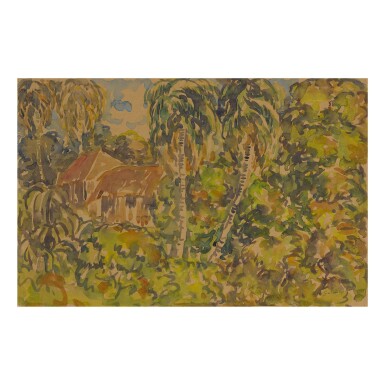Auctions
Buy Now
Collectibles & More
Books & Manuscripts
Modern & Contemporary South Asian Art
Modern & Contemporary South Asian Art

PROPERTY OF A PRIVATE NORTH AMERICAN COLLECTION
Auction Closed
March 16, 05:19 PM GMT
Estimate
2,500 - 3,500 USD
Lot Details
Description
PROPERTY OF A PRIVATE NORTH AMERICAN COLLECTION
SHEIKH MOHAMMED SULTAN
1923 - 1994
UNTITLED (VILLAGE SCENE)
Pen, ink and watercolor on paper
Signed 'S.M. Sultan' lower right
14 ¼ x 21 ⅞ in. (36.1 x 55.5 cm.)
Painted circa 1968
Private Collection of Ahmed Saeed Nagi, Karachi
Thence by descent
Acquired from the above
Sheikh Mohammed Sultan is amongst the most influential artists and early pioneers of modern art in Bangladesh, along with Zainul Abedin and Quamrul Hassan. Sultan joined the Calcutta Art School, but left after three years, without obtaining a degree. This was to be the start of a long, lonely and non-conformist life.
From 1949 - 1953, Sultan spent time in West Pakistan, staying in Lahore and Karachi for extended periods where he held exhibitions of his paintings. He left for East Pakistan (present day Bangladesh) in 1953 and lived in his home town of Narali. However, in 1967 he returned to Karachi where he stayed until 1971. This period was marked by his friendship and close association with Sadequain. The two were often seen together in cafes, drawing and discussing topics of varying interest. It was one of the most prolific periods of Sultan’s life, as he produced a large body of work that included canvases based on his travels to Kashmir, water-colours and pen-and-ink drawings on brown coloured wrapping paper that was commonly available in those days. He mostly painted village scenes with huts, covered in thickets of bamboo, coconut, betel nut and jackfruit. He later took to painting the hard-working farmers and fishermen and women of his home land.
In Karachi, Sultan lived as a house guest for extended periods with his friend and artist Ahmed Saeed Nagi (1916 - 2006). 'The enormous amount of water-color painting and pen-and-ink drawing that Sultan did in those days when he lived for some time in Lahore and later mostly in Karachi, is scattered in many homes. However, it is lucky that the biggest collection he left behind, is still lying with artist Nagi, whose guest he remained for long until he left suddenly barely six months before the succession of East Pakistan, in 1971.' (S. Amjad Ali, Painters of Pakistan, National Book Foundation, 1995, unpaginated)